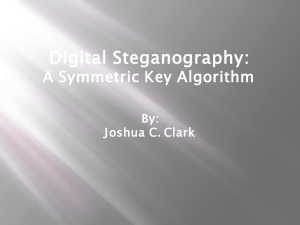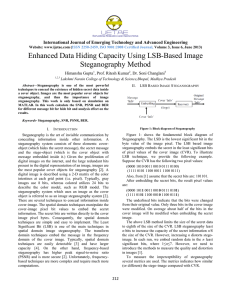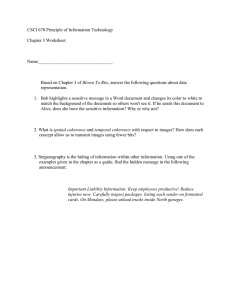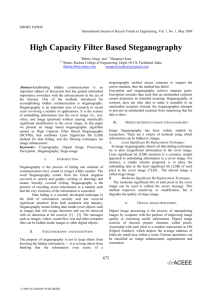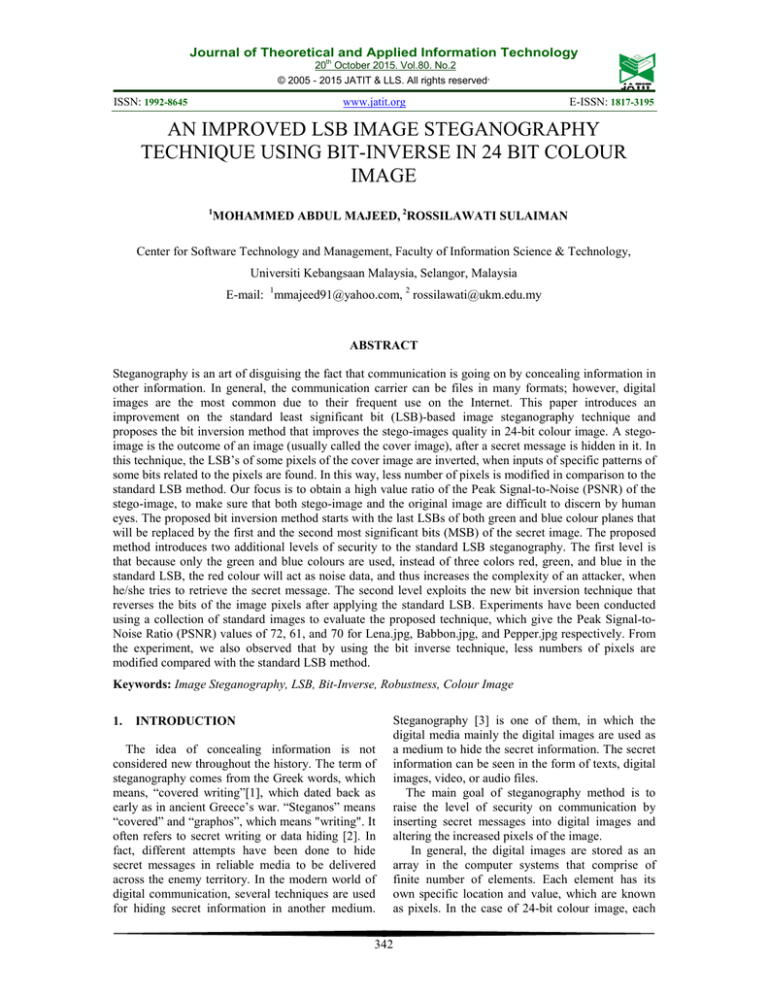
Journal of Theoretical and Applied Information Technology
20th October 2015. Vol.80. No.2
© 2005 - 2015 JATIT & LLS. All rights reserved.
ISSN: 1992-8645
www.jatit.org
E-ISSN: 1817-3195
AN IMPROVED LSB IMAGE STEGANOGRAPHY
TECHNIQUE USING BIT-INVERSE IN 24 BIT COLOUR
IMAGE
1
MOHAMMED ABDUL MAJEED, 2ROSSILAWATI SULAIMAN
Center for Software Technology and Management, Faculty of Information Science & Technology,
Universiti Kebangsaan Malaysia, Selangor, Malaysia
E-mail: 1mmajeed91@yahoo.com, 2 rossilawati@ukm.edu.my
ABSTRACT
Steganography is an art of disguising the fact that communication is going on by concealing information in
other information. In general, the communication carrier can be files in many formats; however, digital
images are the most common due to their frequent use on the Internet. This paper introduces an
improvement on the standard least significant bit (LSB)-based image steganography technique and
proposes the bit inversion method that improves the stego-images quality in 24-bit colour image. A stegoimage is the outcome of an image (usually called the cover image), after a secret message is hidden in it. In
this technique, the LSB’s of some pixels of the cover image are inverted, when inputs of specific patterns of
some bits related to the pixels are found. In this way, less number of pixels is modified in comparison to the
standard LSB method. Our focus is to obtain a high value ratio of the Peak Signal-to-Noise (PSNR) of the
stego-image, to make sure that both stego-image and the original image are difficult to discern by human
eyes. The proposed bit inversion method starts with the last LSBs of both green and blue colour planes that
will be replaced by the first and the second most significant bits (MSB) of the secret image. The proposed
method introduces two additional levels of security to the standard LSB steganography. The first level is
that because only the green and blue colours are used, instead of three colors red, green, and blue in the
standard LSB, the red colour will act as noise data, and thus increases the complexity of an attacker, when
he/she tries to retrieve the secret message. The second level exploits the new bit inversion technique that
reverses the bits of the image pixels after applying the standard LSB. Experiments have been conducted
using a collection of standard images to evaluate the proposed technique, which give the Peak Signal-toNoise Ratio (PSNR) values of 72, 61, and 70 for Lena.jpg, Babbon.jpg, and Pepper.jpg respectively. From
the experiment, we also observed that by using the bit inverse technique, less numbers of pixels are
modified compared with the standard LSB method.
Keywords: Image Steganography, LSB, Bit-Inverse, Robustness, Colour Image
1.
INTRODUCTION
The idea of concealing information is not
considered new throughout the history. The term of
steganography comes from the Greek words, which
means, “covered writing”[1], which dated back as
early as in ancient Greece’s war. “Steganos” means
“covered” and “graphos”, which means "writing". It
often refers to secret writing or data hiding [2]. In
fact, different attempts have been done to hide
secret messages in reliable media to be delivered
across the enemy territory. In the modern world of
digital communication, several techniques are used
for hiding secret information in another medium.
Steganography [3] is one of them, in which the
digital media mainly the digital images are used as
a medium to hide the secret information. The secret
information can be seen in the form of texts, digital
images, video, or audio files.
The main goal of steganography method is to
raise the level of security on communication by
inserting secret messages into digital images and
altering the increased pixels of the image.
In general, the digital images are stored as an
array in the computer systems that comprise of
finite number of elements. Each element has its
own specific location and value, which are known
as pixels. In the case of 24-bit colour image, each
342
Journal of Theoretical and Applied Information Technology
20th October 2015. Vol.80. No.2
© 2005 - 2015 JATIT & LLS. All rights reserved.
ISSN: 1992-8645
www.jatit.org
pixel includes three components of colour that are
Red, Green, and Blue. Thus, three bytes (24 bits)
refer to each pixel to point out to the intensity of
these colours.
Steganography method and cryptography are
different in the sense that while cryptography
focuses on keeping the contents of a message
secret, steganography centres on maintaining the
existence of a message a secret [4]. The word
cryptography is related to the Greek word kryptós
which means unseen, and gráphein refers to the
verb write. In fact, it is a study of conveying the
information from its normal readable format to an
unreadable one.
Nowadays, the combination of steganography
with other methods such as cryptography has
become practiced widely. As a result, information
security has improved considerably. Moreover,
steganography exploits in the exchange of
information.
The least significant bit (LSB) is one of the
steganography techniques that is the simplest and
most famous method, which hides the secret
message directly through concealing the leastsignificant bit of each pixel in an image. Our
proposed technique is based on the standard LSB
technique, an algorithm for 24-bit colour image to
improve the stego-image security based on bit
inversion. This paper is organized as follows:
E-ISSN: 1817-3195
technique that will cater for the above three
properties.
This paper presents an improved LSB-based
steganography by using 24-bit colour image, which
provides more security compared with the standard
method of LSB. Steg-analysis is performed on the
standard LSB stego-image for standards colour
image channels in order to analyses the bit patterns
of the second and third LSBs that occur after the
process of standard LSB. In brief, the proposed
technique in this paper should take into
consideration that any security level improvement
must not affect both capacity and the quality of
stego image
3.
24 BIT COLOR IMAGE
A 24-bit colour image is considered the best in
accordance with the definition of RGB colour
model in which each colour shows as in its primary
spectral component of red, green and blue. This
model is based on Cartesian coordinate system as
shown in Fig 1. Thus, the RGB primary values are
laid in three corners. The secondary colours
recognize as cyan, magenta and yellow, they are
centered at three other corners. Black colour is at
the origin and white is at the farthest corner from
the origin. Equal values include red, green, blue are
consisted the line that links two corners. Therefore,
this produces various shades of grey.
2. THE STANDARD LEAST-SIGNIFICANTBIT TECHNIQUE (LSB)
The preferable technique of steganography
image intends to achieve three aspects [5]: (1) the
capacity of the maximum data that can be stored
within the covered image, (2) the imperceptibility,
which represents the visual quality of stego-image
after data hiding, and (3) the robustness, which is
the difficulty of any unauthorized party to retrieve
the secret data.
Although, the standard LSB-based technique
considers excellent at imperceptibility (the
difficulty to perceive), the capacity of the hidden
data is still low because only one bit per pixel is
used to hide the data. The standard LSB technique
is not robust due to the easiness of retrieving the
secret message. It is easy to retrieve the standard
LSB, because the hidden data is always hidden at
the least significant bit of any stego-image. This
paper focuses on improving the security level of a
secret message, as well as taking into consideration
to increase the capacity of storing the secret data,
and the quality of the stego-image, which
is imperceptibility. This paper proposed a new
Fig 1: Schematic of the RGB color model
The locus of all these points is named the grey
line. In fact, each pixel in the RGB model
composes of RGB values. So, each of these colours
requires 8-bit for its representation. Accordingly,
each pixel signifies by 24 bits in total. So the sum
of possible colors with 24-bit RGB image reaches
(28)3 = 16,777,216.
343
Journal of Theoretical and Applied Information Technology
20th October 2015. Vol.80. No.2
© 2005 - 2015 JATIT & LLS. All rights reserved.
ISSN: 1992-8645
4.
www.jatit.org
LEAST SIGNIFICANT BIT
The LSB based technique is mainly
uncomplicated and simple approach through which
message bits are embedded within the least
significant bits of cover image. In the LSB
steganography method and for the purpose of
covering the secret messages, the least significant
bits of the cover-image are exploited. Thus, this
method is considered one of the most common
techniques that include the standard LSB
replacement [6].
Consider the following cover-image and secret
message in bits. The LSB replacement alternates
the last bits of the cover image with each bit belong
to the messages that are required to be hidden. The
next example is to show the method of standard
LSB replacement. The stego-image is the result
after embedding the secret message.
Cover Image Pixels:
00110011 11101001 01101010 10101001
11011000 10001101 10001100 01101101
Secret Message:
10001110
Result (Stego-image):
00110011 11101000 01101010 10101000
11011001 10001101 10001101 01101100
For RGB, a technique from [6] alternates the
least significant bits of each channel of Red, Green
or Blue with the secret message bits. The result of
the LSBs alternation causes minor changes in the
RGB colours and therefore, it is difficult to be
noticed by the human eye. The following is the
algorithm for LSB-based embedding and extracting
process illustrates as follows [7]:
A LSB-BASED EMBEDDING AND
EXTRACTING SECRET DATA ALGORITHM
LSB-based Embedding Algorithm
Input -: cover C
For i = 1 to Length(c), do
Sj ← Cj
For i = 1 to Length (m), do
Compute index ji where to store the ith message
bit of m
Sji← LSB(Cji) = mi
End for
Output -: Stego image S
E-ISSN: 1817-3195
For i = 1 to Length (m), do
Compute index ji where to store the ith message
bit of m
mji ← LSB(Cji)
End for
In the process of extractions, the fixed messages
can be extracted without any reference to the
original cover-image in the given stego-image S.
The collection of storing pixels in the secret
message bits are chosen from the stego-image by
using similar sequence as in the embedding
process. The LSBs of the selected pixels are
extracted and lined up for the purpose of reforming
the secret message bits.
5.
THE PROPOSED BIT INVERSION
TECHNIQUE
As discussed in the previous section of this
paper, the LSB inversion method can be described
as an operation of inversing the last bit of each
pixel within the cover-image based on the secret
image values. This standard LSB method is
completed when all secret messages’ bits have been
embedded or hidden in the cover-image.
The proposed inversion technique is determined
using the comparison of the 2nd last and 3rd last bit
of the cover-image with the bits from the stegoimage, which is obtained from applying the
standard LSB method. The step-by-step process of
the proposed method is as follow:
1. Calculate the pattern occurrences of these two
bits on the cover-image, which are either 00, 10,
10, or 11. Classify the cover image according
to these four patterns.
2. Apply the standard LSB method to obtain the
stego-image.
3. From the stego-image, once again, calculate the
pattern occurrences in the 2nd last and 3rd last
bit of the stego-image. From these patterns, we
use them as a guide for the inversion steps.
4. Compare between each pattern from cover image
with the same pattern in the stego-image.
5. Inverse the LSB bits if the number of pixels that
have been changed is greater than the number of
pixel that has not change.
6. Store the status of the patterns that inverse its
pixel in specific location.
An example will be used to show the step-bystep process. Consider the following values for
cover image and the secret message:
LSB-based Extracting Algorithm
Input -: Secret image s
344
Journal of Theoretical and Applied Information Technology
20th October 2015. Vol.80. No.2
© 2005 - 2015 JATIT & LLS. All rights reserved.
ISSN: 1992-8645
www.jatit.org
1. Cover image:
10001100, 10101101, 10101011 and 10101101
2. Apply standard LSB method, and labelled the
results as A, B, C, and D.
Secret message
Cover image
: 1011
: 10001100
10101101
A
B
10101011
1010110
C
D
LSB stego-image : 10001101
10101100
A
B
10101011
10101101
C
D
3. From A, B, C, and D, we focus on the 2nd and
the 3rd last bits of bit position such as bold in
(2). From the result, there are four pixels with
two patterns (10, 01).
Three pixels that have ‘10’ pattern (A, B, D)
and one pixel that have ‘01’ pattern (C) .
4. For each pattern, we do the following:
a. For pattern ‘10’, check how many pixels are
changing, and how many are unchanged.
Compare the results with the original cover
image. Result: two has changed (A and B),
and one unchanged (D)
b. For pattern ‘01’ (C), we cannot check how
many pixels were changed and how many
were not, because there is only one pixel,
comparison cannot occur.
c. Finally, we inverse the last bit of the stegoimage, if the number of pixels that have
changed in specific patterns are greater than
the number of pixels that are not changed..
For pattern ‘10’ two pixels has changed (A and
B), and one pixel has not (D), so we inverse the last
bit of ‘10’ pixels as follow:
Cover Image: 10001100 10101101 10101101
stego-image : 10001101 10101100 10101101
result
: 10001100 10101101 10101100
A
A
B
D
In the end, there is only one pixel on the stegoimage which is different from the original image,
which is (D). Thus, the PSNR value of the stegoimage would increase, improving the quality of the
stego-image. To recover the secret message from
the stego-image, we need to store these patterns for
which the corresponding LSB bit has been inverted.
Since we have checked all possible combinations of
the 2nd and the 3rd bit of all pixels, we may need to
store maximum of 4 patterns information in the
stego image.
So in de-steganography, the information that
leads us to the pixels patterns that has been inversed
E-ISSN: 1817-3195
is to firstly read from the stego-image to know
which pattern was inversed and which pattern was
not. Then classify the stego-image according to the
four patterns and next is to re-inverse the bits in
order to extract the massage bits.
According to a research that was conducted by
Hecht [8], 65% of all cones of human eyes are
sensitive to red, 33% are sensitive to green, and
only near about 2 % are sensitive to blue. Based on
this research, our proposed approach used only the
green and blue channel from RGB image in order to
apply the bit inversion method on it to improve the
security. The red colour will act as noise data when
an unauthorized user tries to retrieve the secret
message, and thus increases the complexity of
retrieving process.
6. THE PROPOSED BIT INVERSION
ALGORITHM
pic = cover image
msg = secret message
For i = 1 to n
Get char from msg
For each 2 bits
Get pixel from pic
For each colour from green and blue
Get colour value
Cover value = value
Identify the pattern of 2nd and 3rd
bits of the Cover value which are
either (00, 01, 10, or 11)
If msg bit = 1
Insert a 1 in the lest significant
bit of the pixel value
Else
Insert a 0 in the lest significant
bit of the pixel value
Replace the value in the pic
stego value = value
Identify the pattern of 2nd and
3rd bits of the stego value (00,
01, 10, or 11)
End for
End for
End for
For i = 1 to n
Compare between cover value and stego value
to count how many pixel are changed and how
many are not
If number of changed pixels in any pattern of
pic was more than pixels that not changed in
alternative pattern in the stego
Get pixel from pic
For each colour from green and blue
Get colour value
345
Journal of Theoretical and Applied Information Technology
20th October 2015. Vol.80. No.2
© 2005 - 2015 JATIT & LLS. All rights reserved.
ISSN: 1992-8645
www.jatit.org
If the last significant bit of the
value = 1
Insert 0 in the last significant
bit of pixel value
Else
Insert 1 in the last significant
bit of the pixel value
Replace the value in the pic
Store the status of pattern that
inversed his pixels as a map in
specific location
End for
Plane.jpg
7. SIMULATION RESULT
Experimental results are provided in this
section to demonstrate the efficiency of this
proposed method. The current method was applied
on a variety of true RGB colour images (as shown
in figure 2) to show the effectiveness of the
proposed method.
In this paper, we use three true RGB colour
images (Lena.jpg , Baboon.jpg , Peppers.jpg) that
are similar to previously use in ([9, 10] and[11]), so
that we can compare our experimental results with
these three techniques.
Lena.jpg
Tiffany.jpg
Fig 2: Cover images
End for
Cover-Images
E-ISSN: 1817-3195
Original/Secret Message
The following text includes 226 characters or
2881 bits. This text has been selected to test the
proposed method. “In poverty and other
misfortunes of life, true friends are a sure refuge.
The young they keep out of mischief; to the old
they are a comfort and aid in their weakness, and
those in the prime of life they incite to noble
deeds.”
Histogram Analysis
In steganography, in general, histogram analysis
is used to compare image pixels between the cover
image and the stego-image. Histograms indicate the
number of pixels that have colours in each fixed list
of colour ranges and span the image's colour space.
It contains a group of all possible colours in an
image.
Babbon.jpg
Fig 3: Histogram of cover image
Peppers.jpg
trees.jpg
Fig 4: Histogram of the stego-image after standard LSB
346
Journal of Theoretical and Applied Information Technology
20th October 2015. Vol.80. No.2
© 2005 - 2015 JATIT & LLS. All rights reserved.
ISSN: 1992-8645
www.jatit.org
E-ISSN: 1817-3195
Table 1: PSNR of Different cover images
Cover Image
Lena.jpg
Baboon.jpg
Peppers.jpg
tree . jpg
Plane. Jpg
tifanny. Jpg
PSNR
72.4829
60.5079
69.7691
71.116
69.6063
70.0804
Fig 5: Histogram of stego-image (proposed LSB method)
Comparison is made between histograms of
cover-images and the stego-images, it could be
observed that the histograms of the stego-image of
24 bit colour image (in Figure 5) is almost similar
to the cover-image (Figure 3) and Figure 4. There is
almost insignificant change in colour intensity.
Peak Signal-to-Noise Ratio (PSNR):
In In steganography technique, PSNR is the
standard measurement uses to test the quality of the
stego images. PSNR defines ratio lies between the
maximum possible power of a signal and the power
of corrupting noise that affects the fidelity of its
representation [8]. In this case, the signal is the
cover-image, and the noise is the error that is
introduced by the bits of the secret image. Higher
value of PSNR means higher quality of the stegoimage. To illustrate that, consider a cover image C
of size M × M and the stego-image S of size N × N.
Then, each cover-image C and stego-image S will
have pixel values of (x, y) from 0 to M-1, and 0 to
N-1 respectively [12]. The mean square error
(MSE) which measures the average of the squares
of the errors is calculated first. Then, the result is
used to calculate the PSNR.
Where
Here, αi,j is the pixel of the cover image where
the coordinate is (i, j), and βi,j is the pixel of the
stego-image where the coordinate is (i, j). M and N
represent the size of the image. A large PSNR value
points out that the variation between cover image
and stego image is significantly considered
unnoticed to the human being eye. Table 1 shows
the PSNR values for all cover images, while Table
2 shows the comparison of the PSNR values in (dB)
from the literatures.
Table 2: Comparison of the PSNR values in (dB) from
the literatures
Cover
Image
Improved
Novel
Steganogr
aphic
Techniqu
e For
RGB [9]
Lena 50.99
Baboon 50.98
Peppers 50.06
8.
In Highly
Randomiz
ed Image
using
Secret
Key[10]
49.2668
48.8766
47.9887
Secret
Key
Method
[11]
53.7618
53.7558
53.7869
Proposed
method
72.4829
60.5079
69.7691
DISCUSSION AND CONCLUSION
From the experimental results, high values of
PSNR have been obtained and compared with
previous findings, which indicates that the proposed
method is very efficient in hiding data, which
means that this technique is able to keep changes to
the stego-image to minimum. Therefore, we can
conclude that this technique have good quality of
invisibility and undetectability. In terms of security
property, two additional levels of security were
added to the standard LSB steganography. The first
level is that this technique only uses the green and
blue colours, instead of three colours red, green,
and blue, in the standard LSB. The advantage of
this is that the red colour will act as noise data, to
the any possible attacker with the intention to
extract the message. As a result, this will make the
extraction process more difficult. The second level
exploits the new bit inversion technique, which
reverses the bits of the stego image pixels after the
standard LSB is applied. In the proposed technique,
we have introduced a new bit inversion technique
of steganography.
We would like to emphasis that the goal of the
technique is not just to increase the capacity of the
message but we also try to make it difficult to any
unauthorized party to determine the presence of a
secret message. In the standard LSB technique, the
secret message bit will simply be replaced with the
LSB bit of the image. However, in our algorithm, in
347
Journal of Theoretical and Applied Information Technology
20th October 2015. Vol.80. No.2
© 2005 - 2015 JATIT & LLS. All rights reserved.
ISSN: 1992-8645
www.jatit.org
addition to replacing the message bit, it also inverts
the bits in order to increase both security level of
LSB. Therefore, quality of stego-image is
increased; since it manages to inverse the bits
minimally, and this this proposed method improved
the weaknesses of using the standard LSB
Steganography.
E-ISSN: 1817-3195
[11] Maurya, S. and V. Shrivastava, An Improved
Novel Steganographic Technique For RGB
And YCbCr Colorspace. 2014.
[12] wang, c.-m., et al., a high quality
steganographic method with pixel-value
differencing and modulus function. journal of
systems and software, 2008. 81(1): p.150-158.
REFRENCES:
[1] Vijay Kumar Sharma and Vishal Shrivastava, “
A Steganography algorithm for Hiding Data in
Image by Improved LSB Substitution by
Minimize Detection”, Journal of Theoretical
and Applied Information Technology, 15th
February 2012, Vol36 No.1
[2] Moerland,
T.,
“Steganography
and
Steganalysis”, Leiden Institute of Advanced
Computing
Science,
www.liacs.nl/home/
tmoerl/privtech.pdf
[3]Amin, M.M., et al. Information hiding using
steganography.
in
Telecommunication
Technology, 2003. NCTT 2003 Proceedings.
4th National Conference on. 2003. IEEE
[4] Wang, H. and S. Wang, Cyber warfare:
steganography
vs.
steganalysis.
Communications of the ACM, 2004. 47(10): p.
76-82.
[5] c. Kessler. (2001). Steganography: Hiding Data
within Data. An edited version of this paper with
the title "Hiding Data in Data". Windows & .NET
Magazine.
http://www.garykessler.net/library/steganograp
hy.html
[6] Chan, C.-K. and L.-M. Cheng, Hiding data in
images by simple LSB substitution. Pattern
recognition, 2004. 37(3): p. 469-474.
[7] Neil F. Johnson, S.C. Katzenbeisser,”A survey
of steganography technique”.
[8] Rawat, D. and V. Bhandari, A Steganography
Technique for Hiding Image in an Image using
LSB Method for 24 Bit Color Image.
International Journal of Computer Applications
(0975–8887), 2013. 64(20).
[9] Karim, S.M., M.S. Rahman, and M.I. Hossain.
A new approach for LSB based image
steganography using secret key. in Computer
and Information Technology (ICCIT), 2011
14th International Conference on. 2011. IEEE.
[10] Dagar, S. Highly randomized image
steganography using secret keys. in Recent
Advances and Innovations in Engineering
(ICRAIE), 2014. 2014. IEEE.
348

